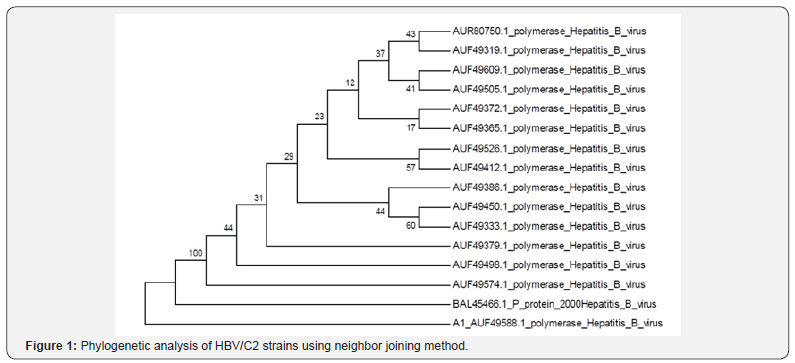Detection of Genetic Alteration of Polymerase Protein of Hepatitis B Virus Strain C2 Isolated From Bangladesh
Modhusudon Shaha1*, Bithi Roy2, Tanzina Akter3, Md. Ekramul Karim3, Md Moniruzzaman4 and Abu Hashem1
1Microbial Biotechnology Division, National Institute of Biotechnology, Bangladesh
2Department of Agronomy, Bangladesh Agricultural University, Bangladesh
3Environmental Biotechnology Division, National Institute of Biotechnology, Bangladesh
4 Molecular Biotechnology Division, National Institute of Biotechnology, Bangladesh
Submission: April 24, 2018; Published: May 16, 2018
*Corresponding author: Modhusudon Shaha, Microbial Biotechnology Division, National Institute of Biotechnology, Bangladesh.
How to cite this article: Modhusudon S, Bithi R, Tanzina A, Md. E Karim, Md Moniruzzaman. Detection of Genetic Alteration of Polymerase Protein of Hepatitis B Virus Strain C2 Isolated From Bangladesh. Adv Biotech & Micro. 2018; 9(2): 555758. DOI: 10.19080/AIBM.2018.09.555758
Abstract
The changes in polymerase gene of Hepatitis B virus (HBV) is increasing rapidly. HBV/C2 strain predominating with the frequent molecular changes in Bangladesh. Herein, the pattern of the changes of polymerase protein of HBV/C2 is reported. The strains isolated in 2017 comprise several amino acid substitutions and were found phylogenetically distinct from the strain isolated in 2000. The rapid changes of the protein due to change in genetic makeup may bring HBV disaster in near future.
Keywords: Hepatitis B virus sub-genotype C2; Polymerase; Phylogeny
Introduction
Hepatitis B virus (HBV) belongs to the Hepadnaviridae family with a unique partially double stranded DNA [1,2]. Since the existence, HBV renders a gradual genomic changes due to the lack of some regulatory systems such as proof-reading activity of polymerase enzyme during replications [3]. Currently, HBV has been reported to have ten genotypes and multiple sub-genotypes [4]. Globally, more than 2 billion people have been infected by HBV and above 300 million are chronically infected annually [3,5]. Bangladesh also bears a high rate of HBV infection, some of which were reported to cause liver cirrhosis and hepatocellular carcinomas [3].
Among the HBV types, sub-genotype C2 (HBV/C2) are the most prevalent in Bangladesh, which was reported to cause most of the chronic infections in previous studies [6]. From the literature, HBV/C2 is also responsible to cause liver cirrhosis and other liver complications frequently [7]. Furthermore, the treatment of this strain is also getting difficult due to the resistance to the antiviral. Resistances to the antiviral are commonly due to the mutations in the polymerase gene as the antiviral drugs neutralize infections based on the inactivation of viral polymerase protein [3]. However, information about the pattern of changes in the polymerase protein of HBV is scarce. Hence, in this study, we determine the Genetic changes of HBV/C2 polymerase protein sequences isolated in Bangladesh
Materials and methods
Polymerase protein sequences of 15 HBV/C2 strains were collected from NCBI Gen Bank. The sequences were then analyzed bio informatically for amino acid substitutions using Bio Edit version 7.1.9 [8] and the sequence, BAL45466 (documented to be isolated in 2000) was used as reference strain. Furthermore, phylogenetic analysis of the sequences with an out group sequence of sub-genotype A1 (AUF49588) was performed using MEGA6 [9]. The accession numbers of the sequences used in this study were AUR80750, AUF49609, AUF49574, AUF49526, AUF49505, AUF49498, AUF49450, AUF49412, AUF49386, AUF49379, AUF49372, AUF49365, AUF49333 and AUF49319
Results and Discussion
Analysis of the HBV/C2 polymerase protein sequences from Bangladesh using Bio Edit revealed some common substitutions different from the reference sequence of HBV/C2 strain isolated in 2000. The substitutions include E73D, N81H, Q85K, E93Q, Y95F, T101V, A137T, K143Q, S196P, C213S, L218F, K229Q, L232M, R234M, S237P, S242I, P249S, R253Q, H267N, D281V, H305Q, F321L, Q327K, T340S, H355Y, N359H, I437L, N468I, L613Q, I615L, V624I, S663A, H683N and R713Q. These substitutions are the fates of the genomic changes in last 17 years, some of which may have potential medical significance to be responsible for drug resistance. Furthermore, phylogenetics analysis with the sequences rendered a close relationship between the sequences isolated in 2017 and a distinct difference with the reference strain isolated in 2000 (Figure 1). The interdifference between the isolates of 2000 and 2017 may indicate a possible evolution of the strain, which may rise extensively in near future.

Conclusion
In conclusion, the genetic diversity of HBV/C2 strains is quite frequent compare to others near inheritance. The drastic changes in amino acid compositions in the genome may denote another evolution of the strain which may bring the disease burden more complicated in future.
Data Availability
The HBV/C2 strain polymerase protein sequences were retrieved from NCBI Gen Bank and are described in methods section.
Conflict of Interest
The authors declare no conflict of interest.
References
- Gao W, Hu J (2007) Formation of hepatitis B virus covalently closed circular DNA: removal of genome-linked protein. J Virol 81(12): 6164- 6174.
- Shaha M, Das KC, Hossain MS, Jahan M, Hashem A, et al. (2018) Complete genome sequence of a circulating hepatitis B virus genotype C strain isolated from a chronically infected patient identified at an outdoor hospital in Bangladesh. Genome Announc 6(9).
- Shaha M, Hoque SA, Rahman SR (2016) Molecular epidemiology of hepatitis B virus isolated from Bangladesh. Springerplus 5(1): 1513.
- Sunbul M (2014) Hepatitis B virus genotypes: global distribution and clinical importance. World J Gastroenterol 20(18): 5427-5434.
- Shaha M, Hoque SA, Ahmed MF, Rahman SR (2015) Effects of risk factors on anti-HBs development in hepatitis B vaccinated and nonvaccinated populations. Viral Immunol 28(4): 217-221.
- Munshi SU, Tran TTT, Vo TNT, Tabassum S, Sultana N, et al. (2017) Molecular characterization of hepatitis B virus in Bangladesh reveals a highly recombinant population. PLoS One 12(12): e0188944.
- Chen YM, Wu SH, Qiu CN, Yu DJ, Wang XJ (2013) Hepatitis B virus sub genotype C2- and B2-associated mutation patterns may be responsible for liver cirrhosis and hepatocellular carcinoma, respectively. Braz J Med Biol Res 469(7): 614-622.
- Hall TA (1999) BioEdit: a user-friendly biological sequence alignment editor and analysis program for Windows 95/98/NT. Nucleic Acids Symp Ser 41: 95-98.
- Tamura K, Stecher G, Peterson D, Filipski A, Kumar S (2013) MEGA6: molecular evolutionary genetics analysis version 6.0. Mol Biol Evol 30(12): 2725-2729.






























